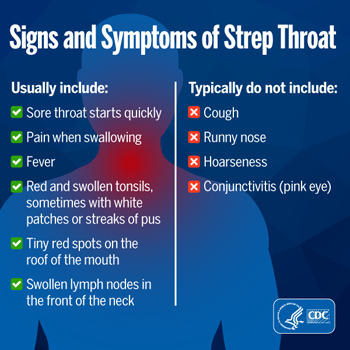
Children often come down with sore throats commonly caused by colds, viruses and, environmental factors such as smoke, dust in the air, and plant allergens. The concern is when a sore throat involves Strep, which is different and can lead to serious complications if left untreated. The throat infection is caused by bacteria named Group A Streptococcus.
Strep throat is contagious and most often affects children younger than 16. It is most common in winter and spring, according to Centers for Disease Control and Prevention (CDC 2018). You can acquire strep throat when exposed to an infected persons nose and mouth secretions, most frequently from coughs and sneezes. (Live Science)
Signs, Symptoms Group A Strep Infection

In general, strep throat is a mild infection, but it can be excruciatingly painful. The most common symptoms of strep throat include:
- A sore throat that starts very quickly
- Pain when swallowing
- Fever
- Red and swollen tonsils, sometimes with white patches or streaks of pus
- Tiny, red spots (petechiae) on the roof of the mouth (the soft or hard palate)
- Swollen lymph nodes in the front of the neck
Other symptoms may include a headache, stomach pain, nausea, or vomiting, especially in children. Someone with strep throat may also have a rash known as scarlet fever (also called scarlatina). It usually takes two to five days for someone exposed to Group A Strep to become ill. (CDC 2018)
Complications of Group A Strep
Untreated strep throat that does not improve within two days could indicate the presence of another infection and the spread of the strep bacteria can go to other areas outside of the throat or produce a systemic inflammatory reaction. Group A Strep (GAS) can infect the tonsils, sinuses the middle ear, skin, and blood. More serious Strep complications can present as kidney inflammation or cause Rheumatic Fever. Rheumatic Fever can lead to painful and inflamed joints, a specific type of rash, or heart valve damage. (Live Science 2018)
It is imperative that a sore throat that lasts more than a few days with the other symptoms be properly diagnosed and have the proper medication prescribed to prevent these life-threatening complications.
What is Group B Strep (GBS)?
Group B Streptococcus (GBS) bacteria are found generally in the intestine, vagina, and rectum in about 25% of all healthy pregnant women. Therefore, Group B strep screening is advised to all pregnant women in their 3rd trimester as the infection can easily pass on to newborns. The illness caused by this infection can be within six hours of birth (early-onset) or weeks or months after birth (late-onset). (Mayo Clinic)
On average, approximately 1,000 babies in the United States develop the early-onset disease each year, with similar rates for late-onset disease. According to the U.S. Centers for Disease Control and Prevention (CDC), the rate of early-onset infections has decreased from 1.7 per 1,000 live births in 1993 to 0.22 cases per 1,000 births in 2016. (MedicineNet 2019)
What Causes Group B Strep?
The bacteria do not spread through food, water, or anything that people might encounter biologically. How people get these bacteria or spread them to others is generally unknown. Other people that live with someone who has GBS bacteria, including other children, are not at risk of getting sick. (CDC)
Signs & Symptoms of Group B Strep
In infants, signs and symptoms might include high fever, difficulty feeding, and breathing, sluggishness and lethargy, irritability, and sometimes jaundice.
The group B strep test is a routine antenatal test, and it involves taking a swab of the inside of the vagina. A doctor or midwife will do this. The swab is taken at 35 to 37 weeks pregnancy. Tests done earlier in a pregnancy aren’t a good guide to the condition at birth because the bacteria can come and go. (Pregnancy Birth Baby)
Treatment by Healthcare Professionals
A pediatrician or a neonatologist will treat babies who develop a GBS infection, and sometimes an infectious disease specialist may be involved. A positive antenatal test will mean the Mom will get IV antibiotics during labor, most commonly penicillin. (MedicineNet 2019)
Preventive Measures for Strep A Infections
Though strep throat is not a medical emergency, you should see your pediatrician within a day or so if you suspect your child may have Strep A.
Handwashing is one of the best ways to prevent the spread of common infections, including strep throat. It is especially helpful when you are spending time in places where harmful germs are more common, such as hospitals, nursing homes, childcare centers, and schools.
If diagnosed with strep, there are some measures you can take to prevent reinfection and spreading infection to family members.
- Take all the medicine your doctor prescribed, even if you start to feel better. Some bacteria may live and rebound if you stop the medication too soon.
- Once you have been on antibiotics for 2 to 3 days, throw out your old toothbrush and get a new one.
- Stay out of work or school for at least 24 hours after you start taking an antibiotic.
- Avoid sharing personal items such as food plates, food items, toothbrushes, fork or knives, etc.
(WebMD 2018)
Helpful Tips for Those Infected
Take care of the person infected with Strep throat, especially children. Kids get dehydrated faster, so provide them with plenty of liquids. Avoid orange juice, grapefruit juice, lemonade, or other acidic beverages, which can irritate a sore throat. Gargling with warm salt water, using a humidifier, and eating soft and cold foods can also soothe the throat.
A visit to your primary care physician should be scheduled when Strep A symptoms are presented. If accompanied by a high fever or rash, a trip to the emergency room may be a better precaution, especially if symptoms are in a child under three years old or an elderly person.
Works Cited
“Worried Your Sore Throat May Be Strep?” Centers for Disease Control and Prevention, Centers for Disease Control and Prevention, 1 Nov. 2018, https://www.cdc.gov/groupastrep/diseases-public/strep-throat.html.
Bradford, Alina. “Strep Throat: Symptoms and Treatment.” LiveScience, Purch, 15 Oct. 2018, https://www.livescience.com/34800-strep-throat-symptoms-treatment.html.
“Group B Strep Disease.” Mayo Clinic, Mayo Foundation for Medical Education and Research, 15 Aug. 2019, https://www.mayoclinic.org/diseases-conditions/group-b-strep/symptoms-causes/syc-20351729.
Doerr, Steven, and Jerry R. Balentine. “How Did I Get Group B Strep? Test, Treatment, Symptoms, Pregnancy, Baby.” MedicineNet, 12 Sept. 2019, https://www.medicinenet.com/group_b_strep/article.htm.
“GBS.” Centers for Disease Control and Prevention, Centers for Disease Control and Prevention, 21 May 2019, https://www.cdc.gov/groupbstrep/about/transmission-risks.html.
Biggers, Alana. “Everything You Need to Know About Strep Throat.” Healthline, 20 Aug. 2019, https://www.healthline.com/health/strep-throat.
“Group B Strep Test.” Pregnancy Birth and Baby, https://www.pregnancybirthbaby.org.au/group-b-strep-test.
Chang, Louise. “Strep Throat Prevention: How To Avoid Catching Contagious Strep.” WebMD, 9 Sept. 2018, https://www.webmd.com/oral-health/understanding-strep-throat-prevention#1.
















